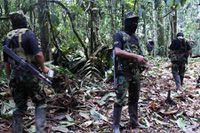Wechua Spring
| The Wechua Spring | |||||||
|---|---|---|---|---|---|---|---|
  [Top] The Grito of Apurimaq, the first demonstration in the Wechua Spring. [Bottom] Kʼanchaq Ñan Insurgent Troops. |
|||||||
|
|||||||
| Factions | |||||||
Supported by: |
|||||||
| Commanders and leaders | |||||||
| Pacha Pinchi (CSWN); Awak Huanca Cocha (Social Democrat); Jaillita Pinto (KÑ). | HM Manco Cápac; Kayara Mayhuasca Soncco; General Phakchay Chaupin. |
||||||
| Units involved | |||||||
| Kʼanchaq Ñan | |||||||
The Wechua Spring, also referred to as the Wechua Revolution, was an armed conflict between the government of the Wechua Nation and the insurgent Kʼanchaq Ñan (Shining Path) guerrilla group, which is the armed wing of the Communist Soviet of the Wechua Nation (known as the CSWN, or the "Ceswan").
The Wechua Spring began as a wave of both violent and non-violent demonstrations, protests, and riots in 1661 AN in the cities of Apurimaq and Rimarima, organized by the Social Democrat Club and the Communist Soviet of the Wechua Nation. These protests earned the support of many due to dissatisfaction with the government of the Inkap Rantin Kayara Mayhuasca Soncco, steep increases in the prices of food and fuel, and high youth unemployment. Violent clashes between protesters and government forces in these cities triggered larger demonstrations in other cities like Parap, Auquimarca, and Huichajanca.
After years of fighting between insurgent guerrilla groups aiming to overthrow the Sapa Wechua, overwhelming material support from the Raspur Pact turned the tide of the war decisively in the favor of government forces. Flush with the fruits of victory the government felt it could be magnanimous rather than vengeful towards its foes and negotiations between the Communist Soviet of the Wechua Nation and other factions led to the Wechua Peace Accords. The new Constitution was subsequently approved by a national Constitutional Referendum agreed upon by as part of the peace settlement.
Background
The Wechua Nation became an internationally recognized independent, sovereign nation in 1657 AN. The following years were marked by the rapid development of the country under the leadership of the young and inexperienced Sapa Wechua Manco Capac and the government of the Inkap Rantin Kayara Mayhuasca Soncco and a cadre of several advisers and counselors to both.
State of the Wechua Economy
- Deep Wechua recession, manufacturing ability degraded by closure/bankruptcy of many factories, industry.
- High unemployment.
- Corruption in government.
- Conviction of several close advisors of the King for leaks, corruption, indecency.
The Wechua Labor Movement
- Political clubs of the left become involved in helping a nascent labor movement organize.
- Formation of several unions, Great Wechua Strike, the bankruptcy of United Wechua Factories wipes out pensions for thousands.
Wechua Political Realities
- King overly insulated from advice and counsel by corrupt bureaucracies, advisors, and politicians.
- King's National Poor Fund runs out of money under the National Poor Fund Scandal.
1661: Grito de Apurimaq
Cabildo Abierto
Soviet Insurgency
Operation Custodian
As the security situation in the western regions of the Wechua Nation deteriorated, the Caputian Government, under the administration of Royston Merrick, authorised an intervention to secure the Franja Transversal del Oeste, a tribal region located between Caputia and Wechua under the direct administration of the Military of the Wechua Nation, whilst simultaneously sealing the border between the Caputian state of San Luis and the frontier city of Apurimaq, heartland of the leftist rebellion.
Ostensibly Operation Custodian, beginning on 05.XII.1662 was intended to stabilize the common Caputia-Wechua frontier and permit the Kuriquinga Wamani (Wechu: "Vulture Corps") to redeploy against the insurgency. However, the unilateral and uncoordinated nature of the sudden Caputian intervention, spearheaded by the 3rd Manoeuvre Army resulted in a number of bloody confrontations and weeks of subsequent skirmishing until a demarcation line following the border between the Franja and Wechua proper was established.
As a landlocked nation, Wechua imported all of its petroleum supplies from Caputia. Roughly 300 fuel trucks enter from Caputia on a normal day, but with the implementation of border restrictions, this dwindled to a sporadic passage of 5–10 fuel trucks daily, though shipments of perishables like fruits and vegetables were generally allowed to pass after stringent inspection by border guards. Moreover, Caputian authorities also stopped some Wechua trucks at the state's designated Caputian freeport of San Francisco. The blockade choked imports of not only petroleum but also medicines and construction materials.
Fighting also flared up briefly in San Francisco after the Royal Caputian Navy availed itself of the opportunity to seize, under the guise of impounding, the strong submarine arm maintained, somewhat quixotically, by the Wechua military at San Francisco under the terms of the mutual friendship treaty.
The formal protests of the Inkap Rantin were swept aside as the Caputian government was confident that the Sapa Wechua would have to continue to rely upon Caputian friendship if he wished to maintain his throne.
Nonetheless, the high-handed actions of the Merrick administration prompted a surge of nationalist indignation across the Wechua Nation, adding a new seam of support for the soviet insurgency to mine.
1662: The Soviet Offensive
The Grito de Parap
Alexandrian Uprising
Corrupted by self-interest: Caputian support to Wechua Government
Soncco Government Falls
1663: "Majesty, Reform or Die!" - The Sapa Wechua takes command
The March of Manco Cápac
El Cabildo Real
The Night of Revenge
A new constitution
The Wechu Deal
Accession to the Raspur Pact
1664: Operation Mustang
The Normark-Parap air bridge
"Nights of Terror, Days of Horror": The Tawantinsuyu on the Offensive
"How can we make peace if no-one remains alive?": Despair in the rebel camps
"Death or the Green, which is also Death": The capitulation of Rimarima
1665: Wechua Peace Accords
Constitutional Referendum
Period of National Reconciliation
Aftermath
See also
- The Wechua Nation - Forum.




